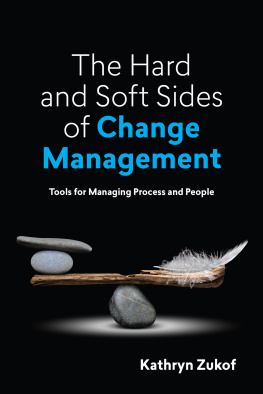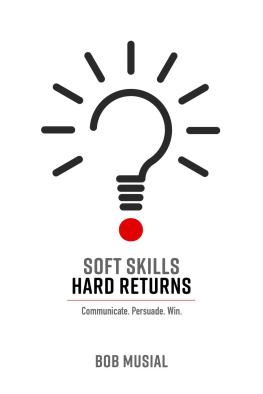Kathryn Zukof - The Hard and Soft Sides of Change Management
Here you can read online Kathryn Zukof - The Hard and Soft Sides of Change Management full text of the book (entire story) in english for free. Download pdf and epub, get meaning, cover and reviews about this ebook. year: 2021, publisher: Association for Talent Development, genre: Business. Description of the work, (preface) as well as reviews are available. Best literature library LitArk.com created for fans of good reading and offers a wide selection of genres:
Romance novel
Science fiction
Adventure
Detective
Science
History
Home and family
Prose
Art
Politics
Computer
Non-fiction
Religion
Business
Children
Humor
Choose a favorite category and find really read worthwhile books. Enjoy immersion in the world of imagination, feel the emotions of the characters or learn something new for yourself, make an fascinating discovery.
- Book:The Hard and Soft Sides of Change Management
- Author:
- Publisher:Association for Talent Development
- Genre:
- Year:2021
- Rating:3 / 5
- Favourites:Add to favourites
- Your mark:
- 60
- 1
- 2
- 3
- 4
- 5
The Hard and Soft Sides of Change Management: summary, description and annotation
We offer to read an annotation, description, summary or preface (depends on what the author of the book "The Hard and Soft Sides of Change Management" wrote himself). If you haven't found the necessary information about the book — write in the comments, we will try to find it.
The Hard and Soft Sides of Change Management — read online for free the complete book (whole text) full work
Below is the text of the book, divided by pages. System saving the place of the last page read, allows you to conveniently read the book "The Hard and Soft Sides of Change Management" online for free, without having to search again every time where you left off. Put a bookmark, and you can go to the page where you finished reading at any time.
Font size:
Interval:
Bookmark:


2021 ASTD DBA the Association for Talent Development (ATD)
All rights reserved. Printed in the United States of America.
24 23 22 21 1 2 3 4 5
No part of this publication may be reproduced, distributed, or transmitted in any form or by any means, including photocopying, recording, information storage and retrieval systems, or other electronic or mechanical methods, without the prior written permission of the publisher, except in the case of brief quotations embodied in critical reviews and certain other noncommercial uses permitted by copyright law. For permission requests, please go to copyright.com, or contact Copyright Clearance Center (CCC), 222 Rosewood Drive, Danvers, MA 01923 (telephone: 978.750.8400; fax: 978.646.8600).
ATD Press is an internationally renowned source of insightful and practical information on talent development, training, and professional development.
ATD Press
1640 King Street
Alexandria, VA 22314 USA
Ordering information: Books published by ATD Press can be purchased by visiting ATDs website at td.org/books or by calling 800.628.2783 or 703.683.8100.
Library of Congress Control Number: 2020951580
ISBN-10: 1-95049-687-2
ISBN-13: 978-1-95049-687-7
e-ISBN: 978-1-95049-688-4
ATD Press Editorial Staff
Director: Sarah Halgas
Manager: Melissa Jones
Community of Practice Manager, Change Management: Lisa Spinelli
Developmental Editor: Jack Harlow
Production Editor: Hannah Sternberg
Text Design: Shirley E.M. Raybuck
Cover Design: Rose Richey
Printed by BR Printers, San Jose, CA
For Max and Will
Its quite a predicament, isnt it? At work, and maybe even in our personal lives, we hear that change is the only constant. We live in a wild, wild world, characterized by volatility, unpredictability, chaos, and ambiguity. To adapt to this ever-changing environment, our organizations introduce even more change. We implement new technology, policies, and procedures. Employees transition to working from home, or they transition back to a brick-and-mortar office environment. New leaders join our organizations and introduce different ideas about how to interact with customers. They change the structure of our workplace, establishing new departments one day and eliminating entire divisions the next. Sometimes these changes produce the kinds of results our organizations are striving to attain. Employees embrace the new technology, and productivity levels increase. The new customer interaction protocol really works, and fewer customers leave.
And yet, far too often, our change efforts come up short. Change is introduced, and we dont achieve the outcome our organization is looking for. Productivity remains the sameor gets worse. Customers continue to leave, perhaps in greater numbers. We try to figure out what went wrong, what we missed, and were told that we shouldnt be surprised by our lack of results. People just dont like change, we hear. Change is hard. Its painful. And most change efforts fail anyway, dont they? You might conclude that implementing change is a hit or miss affair. Sometimes changes work. Often they dont.
So why do we keep at it? Why do we keep introducing changes in the workplace when its something we may not really want to do, when its so challenging, when we do it so badly anyway? Why do we keep trying if we havent figured out how to do it rightor at least, how to do it right more consistently? If our chances of success are just hit or miss, is this really something we should keep on doing?
The easy answer is, we keep at it because we have to. Much of the change happening in todays workplace is driven by factors outside our organizationsby variables that fall, at least in part, outside our control. Customers want less expensive and more personalized products and services, and that means changing what we offer to clients and implementing new forms of delivery. With globalization, companies face increased competition; our workforce is more diverse, and the co-workers we collaborate with may be all around the world, instead of just down the hall or across the street. Rapid advances in technology mean that our business processes may now incorporate artificial intelligence or robotics. Weve had to adjustboth at work and at homeas we take steps to protect our data and ourselves from cyberterrorism. Government regulations that we need to comply with changeand then they change again. Add in a global pandemic, and we may find ourselves reeling.
To respond to all of these external factors, maybe your company has decided to overhaul its business model, like so many retail firms and companies in the hospitality, food, and dining industry did during the COVID-19 crisis of 2020. Maybe your organization is implementing new technologies and work processes. Perhaps youve started to adopt new safety protocols or youre introducing new guidelines for setting up telemedicine appointments. Maybe your workplace is relocating some or all of its employees. Maybe you are relocating. Perhaps you are in the midst of an organizational restructure, in which job roles, responsibilities, and reporting relationships are changing. Maybe your company has acquired a new business, and you now need to figure out how to merge two distinct organizations into one. Or maybe your employer has been acquired, and you have to figure out how to work well with the new parent company. Your organization may be facing financial losses and may be downsizing its workforce. Or business may be booming and you find that the employee population is growing by leaps and bounds. Perhaps new leaders have joined your organization and have announced new ideas they plan to introduce in your company right away.
Maybe change in your workplace truly is the only constant.
The external sources of changeand the steps our organizations take in responsemay seem endless and continuous. In fact, in a recent study conducted by Harvard Business Review in partnership with the consulting firm Strativity, 86 percent of the organizations studied reported that they were conducting multiple change initiatives simultaneously (Percy 2019). That is, different business functionsfrom operations and IT to marketing and finance[were] trying to tackle different issues concurrently. And that study was conducted prior to COVID-19, when suddenly everythingfrom the technology we used to stay connected to our customers and co-workers to our business priorities to simple procedures we needed to follow to enter our places of businesschanged and then changed again and then changed yet again. Were facing lots of changes, constantly, all over the place, and all at once.
Sadly, research also shows that we really arent handling all that change all that well. One often-cited study found that 70 percent of change initiatives fail to deliver on the objectives that were set for them (Ewenstein, Smith, and Sologar 2015). In another, 91 percent of respondents reported that a change initiative had failed in their organizations (Percy 2019). And although some companies successfully navigated the changes that were required to survive during the crisis of 2020, far too many organizations saw their efforts fall short. Research by the consulting firm McKinsey (Blackburn et. al 2020) suggests that companies that will struggle the most to deal with the COVID-19 crisis are reticent to test out new approaches. They arent willing to try something new, fail, learn from their mistakes, and then quickly try a different approach. Change fatigue, defined as the exhaustion that comes from excessive change, may be just one reason employees are reluctant to try something new (Carucci 2019). Our change initiatives also fail when we neglect those affected most by the change and fail to secure their buy-in, when we underestimate the scale and scope of the change as we create project plans, when communications regarding the change are inadequate, and when support from senior leadership is insufficient (Dickson 2019; Sirkin, Keenan, and Jackson 2005).
Font size:
Interval:
Bookmark:
Similar books «The Hard and Soft Sides of Change Management»
Look at similar books to The Hard and Soft Sides of Change Management. We have selected literature similar in name and meaning in the hope of providing readers with more options to find new, interesting, not yet read works.
Discussion, reviews of the book The Hard and Soft Sides of Change Management and just readers' own opinions. Leave your comments, write what you think about the work, its meaning or the main characters. Specify what exactly you liked and what you didn't like, and why you think so.











